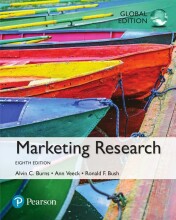Summary: Strategic Management Ibms
- This + 400k other summaries
- A unique study and practice tool
- Never study anything twice again
- Get the grades you hope for
- 100% sure, 100% understanding
Read the summary and the most important questions on Strategic Management IBMS
-
1 Lecture 1 What is Strategic Management?
This is a preview. There are 10 more flashcards available for chapter 1
Show more cards here -
Four characteristics of Strategic Management:
· Interdisciplinary:
o It focuses on the whole organization, rather than any functional part.
· External focus:
o Economy
o Competitors
o Market Demographics.
· Internal focus:
o Understands the resources and capabilities the organization does or does not have.
· Future oriented:
o Decisions
o Planning
o Shifts or changes in products or markets. -
The process (basic activities) of Strategic Management:
· Situation Analysis:
o Scanning and evaluating the current organizational context
o and external and internal environments.
· Strategy Formulation:
o Developing and then choosing appropriate strategies.
· Strategy Implementation:
o Putting strategies into action.
· Strategy Evaluation:
o Evaluating the implementation and outcomes of strategies. -
Strategic Management in Action:
· The Strategic Management process is a continuous cycle:
o It is not a sequential process
o It allows for analysis of the current situation
o Enables adjustments to current strategies as necessary, to pursue and achieve goals. -
Strategic Management: Who is involved, who does it concern?
· Strategic Management is more than the responsibility of top managers
· People at all levels play a role in strategy, and can have strategic responsibilities concerning:
o Development Generating, making, forming, growing a plan of action
o Implementation Putting strategies into action
o Evaluation Determining if strategies are working
o Changing Adjusting strategies to achieve desired goals. -
Six key dimensions of Leadership:
· Effective Strategic Leadership:
o Determining the purpose or vision of an organization
o Exploiting and maintaining core competencies
o Developing human capital
o Creating and Sustaining a strong organizational culture
o Emphasizing ethical decisions and practices
o Establishing appropriate balanced controls. -
2 Lecture 2 The current organization context
This is a preview. There are 14 more flashcards available for chapter 2
Show more cards here -
Industry and Organizational view (I/O) - Input & Output view:
· Focusses on structural forces within an industry
· The competitive environment of firms
· And how these influences competitive advantage
· Involves understanding what makes an industry attractive,
· Choosing an attractive industry in which to compete
· And choosing an appropriate competitive position within that industry. -
Organizational Resources as Competitive Advantage:
· Does it add value?
· Is it rare?
· Is it hard to duplicate and substitute?
· Can the organization exploit it? -
Characteristics of organizations resources:
Value: does it add value in terms of generating and flowing revenues?
Rare: are they valuable and unique resources, and not possessed by competitors?
Ability to exploit: does it offer capabilities and offer opportunities?
Resources are not static: continually building and maintaining resources. -
Competitive advantage is temporary:
o I/O looks at the external environment, particularly the industry and competitors.
o RBV looks inside the organization for unique resources and capabilities to be exploited.
o Guerrilla View recognizes the dynamic environment makes competitive advantage temporary. -
Characteristics of World Class Organizations:
o Strong Customer Focus
o Continual Learning and improvement
o Flexible Organization Structure
o Creative Human Resource Management
o Egalitarian Climate
o Significant Technological Support.
- Higher grades + faster learning
- Never study anything twice
- 100% sure, 100% understanding































